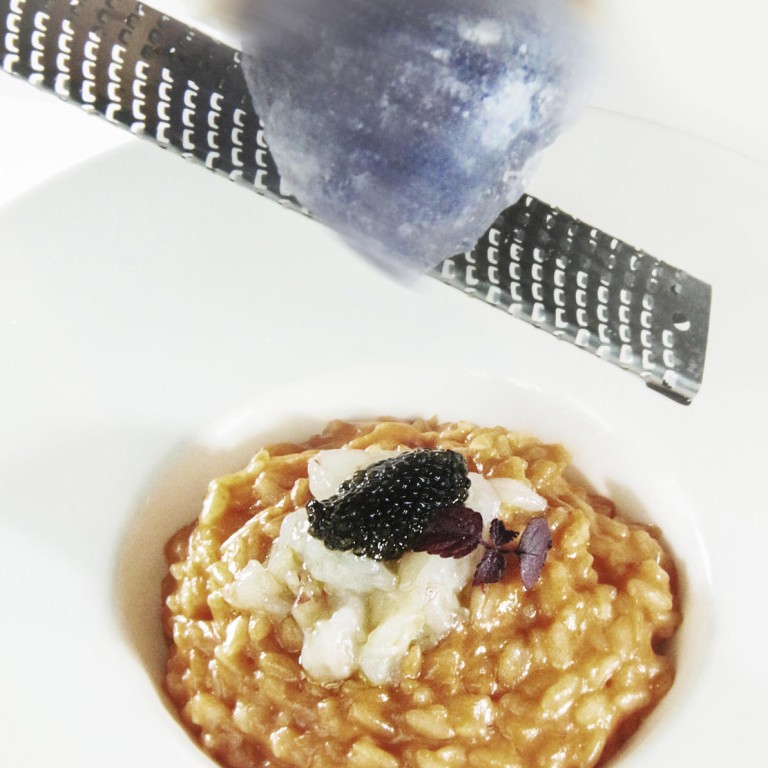
Aqua Armani creates a menu based on rare salt varieties
The use of salt in foodstuffs is often analysed in studies and masticated in the media. Recently, US food science author and former Microsoft tech guru Nathan Myhrvold controversially extolled the virtues of adding a small pinch of salt to a glass of red wine, which he said generally makes it smoother on the palate.
In Hong Kong, one chef has started offering dishes that have been assembled specifically to be paired with rare salt varieties.
"I love salt, but everything needs to be in moderation, and people need to understand what salt should be used for," says Andrea Magnano, executive chef at Aqua Armani restaurant.
"People use it out of habit, particularly in Western foods, whether the dish needs it or not. I get very upset when I see people add salt to a dish before they have even tasted it."
That sounds fair. But Magnano suggests certain types of salt can enhance specific dishes. He has taken this hypothesis a stage further, and is now presenting six dishes, each paired with a rare gourmet salt, in what Aqua Armani calls its Salt Discovery menu, available à la carte or as a tasting menu.
"In the six dishes, the different salt for each brings out certain elements in the dish that you wouldn't experience with a different salt," he says.
"The menu could have been much longer, as I actually use 15 different salts across my dishes at the moment. However, it's not about numbers, but what the salts can do to enhance the flavour profile that I am looking to create."
The experimentation process took several weeks, with a two-pronged approach, he says. "I had dishes that I wanted to create, and then I looked for a particular salt that would enhance it. But some dishes were created as the result of discovering a new salt, and then I worked back from there, thinking what I could do with it."
For the "risotto rosso" Persian blue salt is shaved at the table with some ceremony. For the "three prawns", a pink Himalayan salt brick acts as a serving dish upon which the crustaceans slowly cure. Black Angus tagliata (grilled and sliced steak) sees Egyptian hoar-frost salt dusted on the plate.
In the vongole of Italian clam and mussel, with Spanish baby squid and organic baby plum tomatoes, served on house-made pasta with squid ink reduction, the partnering salt used sounds particularly exotic.
The Hawaiian black lava variety is produced from clear seawater placed in natural lava ponds. Additional lava rocks are added during evaporation, imparting a deep black hue, high mineral content and an earthy smokiness.
One might assume that the differences between natural salt flavours are subtle. Whether mined or evaporated from seawater, salt is always, chemically speaking, sodium chloride. But the Aqua Armani chef is adamant there are perceptible differences between the non-enhanced salts he selected.
"Persian Blue is very salty when you first taste it but its effect on food is that, once the saltiness goes, it helps expose the sweetness of the dish. The hoar-frost looks like tiny ice crystals. It's seriously salty but melts instantly inside the mouth; the flavour of the dish is heightened and there is no grain texture to it - it has a very clean feel," he says.
Magnano and manager Max Rhodes have even paired some cocktails with salt. "My favourite here is the Hendricks Dirty Martini, with stunning Italian olives, floral soft Hendricks gin and an amazing Spanish olive salt - plus a half-salt rim."
At The Steak House winebar + grill in the InterContinental Hong Kong, an international selection of eight salts has been on the menu since 2005.
All selected are high in minerals and low in sodium. Salts from Peru, the Himalayas, Margaret River, Hawaii, Cyprus and Sicily feature, plus, from France, salt smoked using oak wood chips from chardonnay wine barrels.
Chef Calvin Choi says the smokiness of the last type nicely matches the flavour of the restaurant's charcoal-grilled steaks, while the very fine Himalayan pink goes best with seafood as it bring out the natural flavours.
"Guests are most curious about the smoky aroma and taste of the chardonnay-smoked salt, and the Hawaiian sea salt, which is a dark rust colour - due to a small amount of reddish [volcanic alaea clay] content that enriches it with iron-oxide.
"For me, red wine salt is interesting; it has a sweet and sour flavour." Dark chocolate with salt is a known gourmet pairing - and one that Choi implements. "It's a delicious combination," he says.
The Steak House assistant manager Ng Tit-fai says that diners cannot necessarily easily distinguish between different salts, in terms of taste. "The biggest [noticeable] difference is the texture - we advise our diners on how the salt texture will affect their palate when enjoying the steak.
Fine-textured salt goes well with tender steak; crispy and thin-flaked salt goes well with oilier steaks, and hard rock salt matches chewier steaks."
Things to consider before reaching for the salt grinder.
